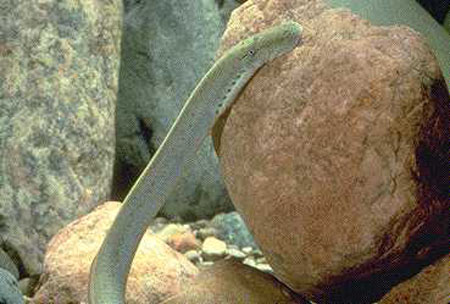|
Distinguished by the following characters: oral disc as wide or wider than head; teeth sharp and well developed; usually 56-62 trunk myomeres; black on lateral-line pores; one slightly notched dorsal fin (Ref. 86798). Other diagnostic features: 11.7-27.9 cm TL. Body proportions, as percentage of TL (based on 51 specimens measuring 12.5-25.9 cm TL): prebranchial length, 10.4-14.0; branchial length, 7.6-10.7; trunk length, 47.3-54.3; tail length, 21.4-31.2; eye length, 0.6-1.8; disc length, 6.2-9.5. The urogenital papilla length, as a percentage of branchial length, in 10 spawning males measuring 11.7-24.7 cm TL, 8.7-16.0. Trunk myomeres, 53-62. Dentition: supraoral lamina, 2-3 teeth (if 3, the median one shortest); infraoral lamina, 5-11 teeth; typically 4 endolateral teeth on each side, but 5 teeth also occur; 7-10, mode of 8, bicuspid endolaterals in total, the other endolaterals, if any, unicuspid; 3-4 rows of anterials, usually 3; first row of anterials, 3 teeth, all unicuspid; 4-8 rows of exolaterals on each side, usually 6; 2 rows of posterials; first row of posterials, 8-9, all unicuspid; transverse lingual lamina moderately to strongly w-shaped, with numerous cusps; longitudinal lingual laminae, number of teeth unrecorded. Velar tentacles, 2-3, smooth. Body coloration (live), slate gray dorsal aspect and silvery gray lateral and ventral aspects. Lateral line neuromasts darkly pigmented, although they may be unpigmented in recently transformed adults. Caudal fin pigmentation, 75% or more. Caudal fin shape, rounded. Oral fimbriae, 103-144. Oral papillae, 20-32 (Ref. 89241). |

